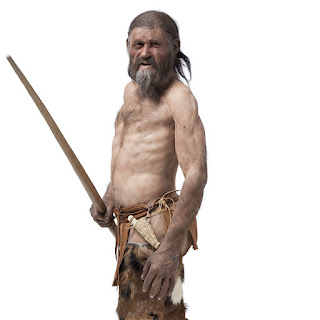Ötzi, the man who came from the ice: the Archaeological Museum of South Tyrol (Bolzano)
 | ||
| The statue of Otzi according to the analysis conducted on the mummy. All rights reserved. |
The real star of Bolzano is Ötzi, a mummy preserved at the Archaeological Museum of South Tyrol: without exaggeration, this is one of the most beautiful and interesting museums I've visited. The risk of a "monothematic" Museum is often to boring the visitor, who walks passively through the various rooms without understanding much receiving the same information. This museum, on the other hand, excites the visitor from the first to the last room: in its 4 floors, the museum summarizes not only the story of Ötzi, but also deals with most of the diagnostic and conservation aspects of the mummy as well as his outfit, in a crescendo of interest and wonder for the visitor (and especially for a Conservation Scientist) who is going to visit it.
Briefly, we recall that Ötzi was found in 1991 in the glaciers of the Val Senales, a few kilometres from the Austrian frontiers (this caused a judicial dispute, a very interesting story because for his return to Italy a highway was closed!). The man, mortally wounded about 5,300 years ago, was found with all his equipment in very good conditions of preservation since the ice had inevitably helped to preserve him.
So, when he was found, there were many questions to solve: what was the cause of death? How old was? What did he have with him? How had his clothes been made? What did he look like? What did he eat?
It is almost superfluous to state that many of these questions have been solved thanks to diagnostic techniques approaching as a modern homicide case.
For example, Ötzi was subjected to a CT scan, which revealed the presence of an arrowhead at the armpit, which probably caused his death due to infection and bleeding. However, the TAC also highlighted other injuries, both previous and contemporary at the time of death, suggesting that our ice man was running away from an assailant. Furthermore, some peculiarities of the Similaun mummy were evident: Ötzi, in fact, had no wisdom teeth and the two incisors were very distant from each other (diastema, a characteristic that we can still found in some individuals, just think of ... Madonna!); besides, he lacked two ribs. Ötzi, however, was not a young man: the investigations established that he could be between 40 and 50 years old, an old man for the life expectation of that age.
Multispectral imaging showed tattoos on Ötzi's skin, in correspondence to worn joints, as if this practice were a kind of primitive acupuncture.
Even more interesting is the recent discovery, published in Current Biology, of the last meal of Ötzi, which allowed adding a piece on the knowledge about the diet of individuals of the Copper Age. In this case the collaboration regard a great deal of forces due to the several analytical techniques used: microscopic analysis, GC-TOF MS, LC / MS, isotopic and elemental analysis, PCR and Raman spectroscopy, just to name a few.
Similarly, the study of ancient DNA has allowed to study the migrations of peoples, discovering that there are still living "descendants" of Ötzi in Austria and that his Y chromosome was typical of Middle Eastern populations.
Naturally, in-depth analyses were also performed on Ötzi's outfit and one of the most interesting data concerned the medicinal herbs he had with him, in particular the Fomitopsis betulina mushroom, currently known for its healing properties. So Ötzi could rely on competent doctors, given acupuncture and medicinal herbs, or was he a shaman himself? This, unfortunately, we will never know for sure.
The Museum dedicates ample space to the diagnostic aspect, both relating to the analyses carried out on Ötzi himself and about the conservation of the mummy and its outfit. For example, it is explained to the visitor how the storage cases of Ötzi's clothes are structured to prevent the bacteria attack.
How was it possible to analyse Ötzi in deep? It was not easy because the mummy is subjected to very restrictive storage conditions and, obviously, it is not possible to let him out of the cold store for a long time. The Museum has provided emergency rules in the event of a blackout, a fire or even stealing for the safety of its Star.
In short, I highly recommend a visit to the Archaeological Museum of South Tyrol to rediscover the incredible story of Ötzi and the long controversy with Austria for his custody. You will enter into a fascinating world, made even more interesting by the interactive panels and scientific information that this avant-garde museum offers us.


Comments
Post a Comment